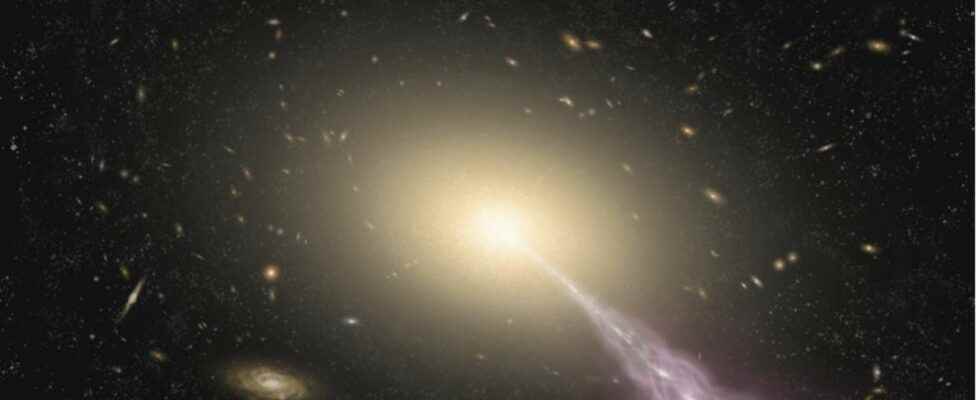3C 273 is a star in the field ofastrophysics and some cosmology. Behind this name, which means in the first place that it is the 273e subject of the third Cambridge catalog listing the sources radio, we find the brightest quasar in the sky. It was discovered in the Virgo Constellation and we now know that this radio source is produced by a supermassive black hole — containing about 887 million masses solar — observed as it was about 2.44 billion years ago.
3C 273 is the most studied quasar, with famous images taken by the telescopes Hubble and Chandra showing in particular a jet of matter approximately 210,000 light-years long and which comes from a elliptical galaxy containing the quasar. Its discovery in the early 1960s paved the way for acceptance of the theory of big Bang as the new paradigm of cosmology.
We have since known that the supermassive black holes who are behind the formidable energy of the quasars — shining more, by themselves, than all the stars of the galaxies which contain them –, comes from theaccretion large amounts of gas. The winds material and the radiation that is produced by this accretion can affect the gas content of galaxies and the rate of star formation from this gas. We also know that there is a relationship of proportionality between the mass of supermassive black holes and those of the galaxies that host it in the vast majority of cases, which implies that the two objects grow together.
There are therefore complex but still poorly understood relationships between the growth processes of these two objects and the fact that we observe that galaxies eventually die, that is to say, to no longer form a star, due to their gas depletion. To see more clearly, it is necessary to be able to study more closely the galaxies which contain quasars and a new illustration of this type of research has just been given by a team ofastrophysicists Japanese via a publication in the famous periodical The Astrophysical Journal. The article in question is as often in free access on arXiv.
850 times dynamic range to unlock the secrets of 3C 273
The researchers conducted their work using theAtacama Large Millimeter/submillimeter Array or Alma (in French: large array of millimeter/submillimeter antennas of the Atacama). Getting more detail about the 3C 273 galaxy with Alma required them to find a new image processing technique to achieve higher dynamic range with the images. digital that allows to form the radio telescope.
Let us recall, to put it simply, that for these images, such as those that can be taken with CCD sensorsthe dynamic range is the interval of value of brightness what the image might represent. However, in a natural environment, there are very large light amplitudes between the different pixel of a digital image so that one can get more information and detail as the dynamic range is.
Typically, the dynamic imaging ranges for frequencies available with Alma are of the order of 100 in the appropriate measurement unit to define them. Japanese astrophysicists managed to get a contrast between the lightest and darkest tones of an Alma image of the order of 85,000, a record with Alma for extragalactic objects.
The researchers then discovered around the supermassive black hole a halo of faint radio emissions but extending over several tens of thousands of light-years. Ordinarily, these diffuse intra-galactic radio broadcasts are produced by the synchrotron radiation relativistic electrons at high speeds, often in magnetic fields. But the intensity of this type of radiation is given by a spectrum which varies with frequency, which is not the case for the halo of 3C 273. In fact the curve of the spectrum is flat.
A radio halo of ionized hydrogen?
Baffled by this observation, astrophysicists have finally found a plausible explanation. L’emission would come from the distributions ofhydrogen in the interstellar medium of the elliptical galaxy, partially ionized by the radiation specific to the matter accreted by the central black hole. The amount of ionized matter is far from negligible because it is estimated at between 10 to 100 billion solar masses. The total spectrum of the light radiated by the ionized gas must end up with a part in the visible. But this part is clearly blocked by the dust in the galaxy, which is not the case with the radio waves in the frequency band accessible to Alma, and it is for this reason that we only now discover the presence of ionized gas in the halo around 3C 273.
But, as the press release on Alma’s site explains, if ordinarily stars cannot form in clouds of strongly ionized hydrogen gas, the amount of un-ionized gas in the elliptical galaxy must remain large because it does not appear that star formation has been strongly suppressed by the active nucleus of the galaxy.
There is always that ” this discovery offers a new way to study problems previously tackled using visible light observations “, according Shinya Komugiprofessor at Kogakuin University in Japan and lead author of the study published in Astrophysical Journal. And he adds at the end of the press release that ” by applying the same technique to other quasars, we hope to understand how a galaxy evolves through its interaction with its central core “.
Françoise Combes, astrophysicist and professor at the Collège de France, explains the latest discoveries about quasars. © Science area
Interested in what you just read?
